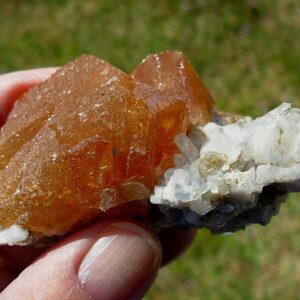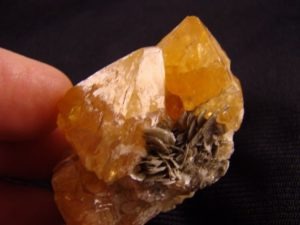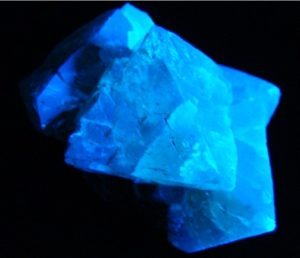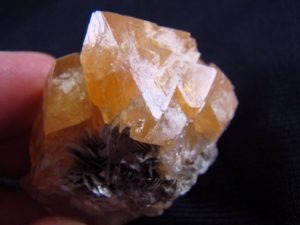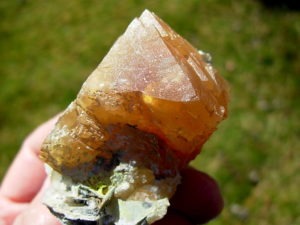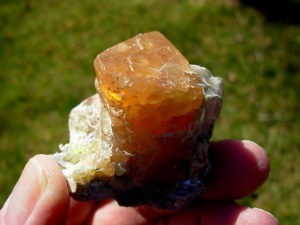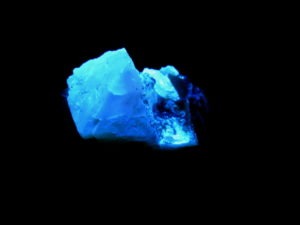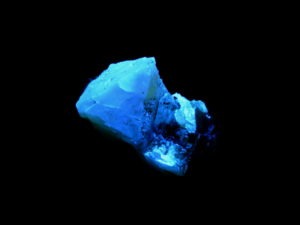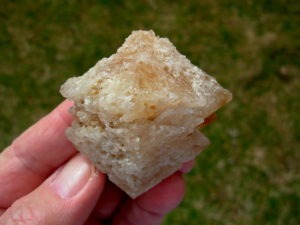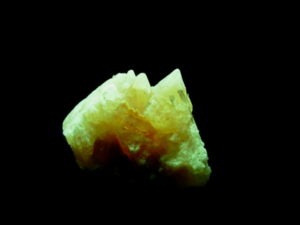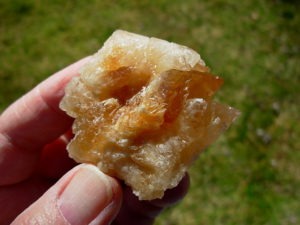Scheelite-Powellite Group
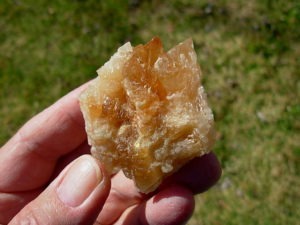 The Scheelite-Powellite Series is an uncommon secondary mineral, typically formed in the oxidation zones of molybdenum-bearing hydrothermal deposits.
The Scheelite-Powellite Series is an uncommon secondary mineral, typically formed in the oxidation zones of molybdenum-bearing hydrothermal deposits.
Scheelite is Calcium tungstate, an important ore of tungsten which is a strategically important metal. Scheelite is named for the discoverer of tungsten, Karl W. Scheele. Scheelite is a “Must Have” for serious mineral collectors. It forms perfect tetragonal dipyramidal crystals that look very much like octahedrons. These pseudo-octahedral crystals are sometimes truncated with minor pyramids, but only on the top or bottom points of the crystal. Other minerals that form pseudo-octahedral crystals similar to Scheelite include Wardite, Anatase and Powellite.
Powellite is associated with Scheelite and it forms similar crystals. The two minerals differ in that Scheelite contains tungsten while Powellite contains molybdenum. Powellite fluoresces yellow while Scheelite fluoresces a bright blue under short wave ultraviolet light. Scheelite has a waxy translucent appearance. Many rockhounds and prospectors looking for Scheelite have made excellent finds by searching old mines and trailings at night with SW Ultra-Violet lights. The bright blue fluorescence of Scheelite is unmistakable!
Powellite is a calcium molybdate mineral, and may occur as well-formed coarse sized granular crystals. It generally occurs as Anhedral to Subhedral crystals in matrix. (A rock with an Anhedral texture is composed of mineral grains that have no well-formed crystal faces. An intermediate texture with some crystal face formation is termed Subhedral.) Euhedral crystals are those that are well-formed with sharp, easily recognized faces.
Euhedral is a morphological term referring to grains in igneous rocks which have a regular crystallographic shape. Euhedral forms are developed when a crystal grows freely in a melt and is uninhibited by the presence of any surrounding crystals. (A melt is the liquid part of silicate magma. Magma may consist solely of melt or of melt and suspended crystals) the shape of the growing crystals will thus be controlled by their own natural crystallographic form.
Anhedral is a morphological term referring to grains in igneous rocks which have no regular crystalline shape. Anhedral forms are developed when a crystal's free growth in a melt is inhibited by the presence of surrounding crystals. The shape of the growing crystal is thus controlled by the arrangement and orientation of the surrounding pre-existing crystals.
Item # SCHE03146588
Rare Specimen of Euhedral Fluorescent Scheelite

Rare Multiple pseudo-octahedral euhedral crystals, that measure up to 25mm per side, with Muscovite. Excellent specimen!! Excellent Fluorescence!! This superb specimen is from our personal collection. It was obtained in 2004 from a mineral dealer in Tucson, Arizona and has been on display in our cabinet. It is from the Mianyang Mine, Mianyang City, Mianyang Prefecture, Sichuan Province, China.
This specimen weighs 0.36 lb (162g) and measures 1.9 x 1.9 x 1.3 inches (4.9 x 4.9 x 3.3cm)
Item # SCHE03142562
136g Fluorescent Scheelite from China

One large pseudo-octahedral euhedral crystal, that measures up to 25mm per side, on attractive Quartz and Muscovite. It is from the Sichuan Province, China. Very nice daylight and fluorescent specimen! Broken edges are from extraction.
This specimen weighs 4.7 oz or 0.3 lb (136g) and measures 1.9 x 1.8 x 1.1 inches (4.9 x 4.5 x 2.8cm)
Item # POWL031459931
Exceptional Fluorescent Powellite from India

Extremely rare and unique Powellite specimen from Nashik. Nashik is a city in the state of Maharashtra in Western India. This specimen is from our personal collection. We obtained it in 1998 from Wally Marks at the Highway 50&95 Rock Shop in Fallon, Nevada during one of our trips to Wonderstone Mountain.
This very unique piece has two distinctly different sides. The top right photo shows the unique coarse crystal habit of two large Euhedral crystal formations which are twinned. The top left photo shows the other side which displays both Anhedral and Subhedral growth patterns, almost trying to achieve Euhedral status...avery special specimen of Powellite which is an excellent daylight and fluorescent display piece.
This specimen weighs 4.3 oz or 0.27 lb (124g) and measures 2.1 x 2 x 1.2 inches (5.3 x 5.2 x 3.2cm)

